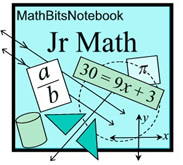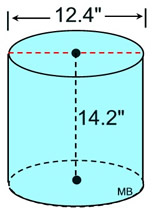|
Cylinders are three-dimensional closed surfaces.
They are not polyhedra since their faces are curved surfaces, not polygons.
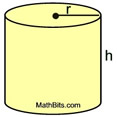 |
In many ways, however, a cylinder is similar to a prism.
A cylinder has parallel congruent bases, as does a prism,
but
the cylinder's bases are circles rather than polygons.
It is possible that the bases of a cylinder may be other curved surfaces, such as ovals,
but for this level course, the bases will be circles.
|
|
A cylinder is a three-dimensional closed figure with congruent, parallel (usually circular) bases connected by the set of all line segments between the two circular bases (forming a curved surface). |
The term "cylinder" is from the Greek meaning "tumbler" or "roller". |
|
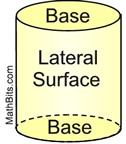
Right Circular Cylinder
|
Regarding circular cylinders:
• |
The bases are circles. |
• |
The bases are parallel and congruent. |
• |
While cylinders have several characteristics in common with prisms, they are not prisms. |
• |
A cylinder sitting straight up and down is called a right circular cylinder. |
|
The word "cylinder" usually refers to a cylinder whose bases are circles, resembling a tin can. A tin can is a right circular cylinder (sitting upright).
At this level, our cylinders will all look like tin cans.
FYI: It may be the case that a cylinder is "slanted", called oblique.
|
 |
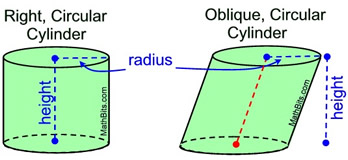 |
If the segments joining the centers of the circular bases are perpendicular to the bases of the circles, the cylinder is called a right circular cylinder. If the segments joining the center of the circles are not perpendicular to the bases of the circles, the cylinder is called an oblique circular cylinder. |

Cross Sections (Plane Sections) of Right Circular Cylinders
|
Parallel to Base
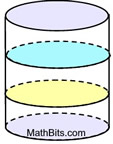 All slices made parallel to the base create "circles" that are congruent to the bases (same size and shape).
All slices made parallel to the base create "circles" that are congruent to the bases (same size and shape). |
Perpendicular to Base
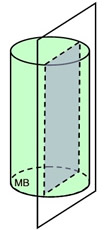 Green: All slices made perpendicular to the base create "rectangles" of varying sizes.
Green: All slices made perpendicular to the base create "rectangles" of varying sizes.
|
Slice Orientation Slanted
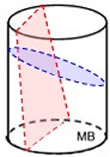 Slices that are not parallel nor perpendicular to the base may create other cross sections such as ovals and trapezoids.
Slices that are not parallel nor perpendicular to the base may create other cross sections such as ovals and trapezoids. |

Volume of a Cylinder:
|
The volume of a cylinder is the area of its base times its height.
 |
|
The volume of a cylinder can be calculated in the same manner as the volume of a prism:
the volume is the product of the base area times the height of the cylinder
(but the "base" of the cylinder will be a "circle").
PRISM Volume: V = Bh CYLINDER Volume: V = (πr2)h
B = area of base. Base of a cylinder is a circle. B = πr2 (for a cylinder)
Since the base of a cylinder is a circle, the formula for the area of a circle can be substituted into the prism's volume formula (V = Bh) for B, giving us V = (πr2)h. |
| |
|
V = volume in cubic units
r = radius of base in units
h = height in units

|
|
Cylinders are commonly seen in everyday life. Food storage "cans" are one example. |
Example:
Find the volume of this right circular cylinder, to the nearest tenth of a cubic inch.
Solution:
• Notice that the diameter is given (12.4), but we need the radius, which is 6.2 inches.
• The height = 14.2 inches.
• The volume formula is V = πr2h = π • 6.22 • 14.2.
V = 1714.8 cubic inches |
|
|

Surface Area of a Cylinder:
|
The surface area of a closed cylinder is a combination of the lateral area and the area of each of the bases. |
|
(For this discussion, our cylinder will be a right circular cylinder.)
When disassembled, the surface of a closed cylinder becomes two circular bases and a rectangular surface (lateral surface), as seen in the net at the right.
The length of the rectangular surface is the same as the circumference of the base. Remember that the area of a rectangle is its length times its width.
The lateral area (rectangle) = height x circumference of the base
= h • 2πr = 2πrh
The base area = area of a circle (remember there are two bases)
=
2 • πr2 = 2πr2
Total Surface Area of a Closed Cylinder
SA = 2πrh + 2πr2
|
 Think of the lateral area as unrolling the label off a tin can.
Think of the lateral area as unrolling the label off a tin can. |
Example:
Find the surface area of this tin can after it has been opened. Express answer in terms of pi.
Solution:
• An opened can will have one base missing, so we need the formula with the area of only ONE circle:
SA = 2πrh + πr2
• Radius is 2" and height is 5".
SA = 2π(2)(5) + π(2)2 = 20π+ 4π
• The surface area: SA = 24π square inches |
|
|

NOTE: The re-posting of materials (in part or whole) from this site to the Internet
is copyright violation
and is not considered "fair use" for educators. Please read the "Terms of Use". |
|
|
